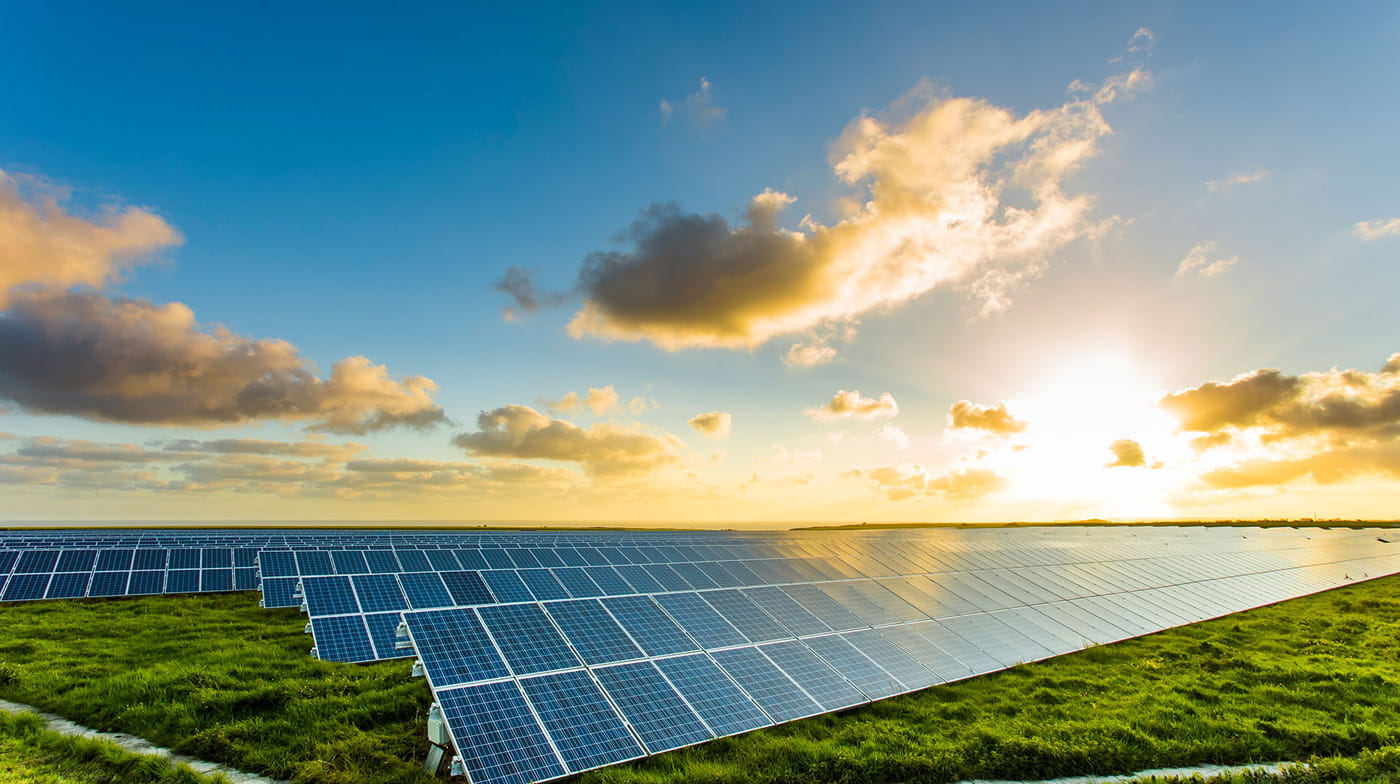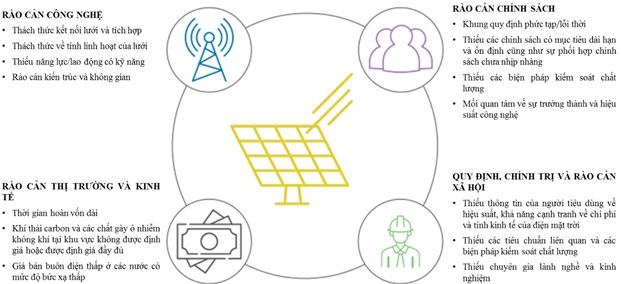Over the years, solar power has made strong developments in the world, making specific contributions to the energy goals and sustainable development of many countries. This development has created new technology trends and appropriate solutions from stakeholders are needed. In which the solution to develop solar power is now popular.

Vietnam’s solar power technology research and development capacity
The research capacity of Vietnam’s solar cell materials is not much inferior to that of other countries in the world. There are even technological processes that have been studied for many years but have not been put into production applications.
For example, the technology of making monocrystalline silicon wafers, Au(Ag)/TiO 2 nanoparticle systems or most recently, advanced materials researched by domestic units (such as: semi-conducting oxide thin films). conduction, silicon heterojunction solar cells with transition metals, one-dimensional nanostructured TiO 2 materials, multilayer and combinatorial organic solar cells, Perovskite materials, quantum dot solar cells, Schottky structure solar cells, photosensitizers…) [1].
Technological research along the value chain of the solar power industry such as: module manufacturing technology, operation and maintenance technology, power industry waste treatment technology, technology to connect solar power to the grid National electricity is not yet developed. The reason is due to the hot development of solar power in a short period of time, leaving us without thorough preparation and technological complexity.
Invest in manufacturing solar power modules of enterprises in Vietnam
According to statistics of clean energy research group Bloomberg NEF, Vietnam currently ranks 7th in the world in solar power output, just behind the US and China in the number of installed solar panels. In 2020, Vietnam’s solar panel imports tripled to 114.6 million panels with a value of up to $2.4 billion (an increase of more than 185%) compared to 2019 [2].
However, the number of businesses in Vietnam that can produce solar cells is very modest, specifically, as of August 2019, Vietnam has only 9 solar battery factories, of which only there are two companies owned by Vietnam, namely: IREX Solar (Vung Tau) and Red Solar Energy Joint Stock Company (Ho Chi Minh City) [3]. Products owned by Vietnamese enterprises are limited in types and concentrated mainly in the low-priced segment.
Thus, the investment in solar power of Vietnamese enterprises is not commensurate with the potential of the market. I think, in the coming period, we really need to have mechanisms and policies to encourage Vietnamese businesses to promote research and development of solar cell products, focusing on productivity and quality of products. to gradually dominate the market.
Development trend of solar power technology in the world
Advanced module technology : the emergence of new cellular structures has given greater efficiency. The main driver of this change is the emergence of PERC cells and their compatibility with new technologies, such as half-cut cells, bifacial solar cells, and increased number of power busbars (Multi-busbars).
The development of modular technology also comes from the manufacture of solar roofing, where solar panels are designed to look like conventional roofing materials, while generating electricity for electricity. increase the aesthetics of the house [4]. However, there are still few energy tile manufacturers and few skilled workers to install. Only a few major manufacturers in the market such as Tesla Solar, Hanergy and Eternit are capable of operating this type [5].
New applications of solar power: following the trend of technological development in the exploitation and use of solar energy in the world, a number of research projects and prototypes at the application level are being carried out to stimulate future market growth. For example, solar tree technology that can generate the same amount of electricity as ground-based solar power but takes up up to 100 times less space, or solar desalination technology that utilizes waste heat from solar panels to provide heat for distillation desalination systems.
In addition to the technologies mentioned above, solar power also tends to develop technology along the value chain. It is technology in operation and maintenance services, PV system management at the end of life, technology that responds to the variability and uncertainty of solar power. These technologies will ensure flexibility, economic-technical efficiency and limit environmental pollution.
Mechanism and main development of solar power: barriers and solutions
Mechanism, main development of solar power including barriers and solutions
1. Barrier
Solar power is one of the strategic renewable energy technologies needed to make the global energy transition in line with the climate goals of the Paris agreement. In general, renewable energy sources are affected to varying degrees by issues due to different project specifications, geographic contexts and maturity levels. For solar power, existing barriers at different levels could hinder the deployment of solar PV installations over the next three decades.

2. Solution
To overcome the above barriers, the Governments of different countries have introduced many regulatory mechanisms to promote the deployment of renewable energy to reduce energy consumption and increase energy access. At the same time, renewable energy deployment is mainstreamed into broader policies to make energy a catalyst for inclusive, sustainable and economic growth. Mechanisms and policies to help developed countries overcome barriers to solar power development include:
3. Deployment policy
The new point of the implementation policy is to focus on setting long-term goals and the stability of financial support tools to help create confidence for investors. Long-term support mechanisms for capacity building or demand response and support schemes for renewable energy are widely used to guide investment in accordance with national priority policies that will attract investment. into private and public renewable energy. These support mechanisms will also motivate investors to accelerate the construction of solar power plants to take advantage of incentives from the government.
Integration policies : the main content of this policy is to deploy distributed energy sources, improve the reliability of power grid infrastructure through systematic digitalization of technology. Engaging the local community, making it a fundamental part of the project, throughout all phases of project development and operation (e.g. through job creation, profit sharing with local people). people). The systematic implementation of these policies will create flexibility throughout the power sector leading to cost reduction, support for the energy transition and especially avoidance of conflicts arising between power owners and owners. private and community.
Support policy : this policy focuses on promoting research and development (R&D) strategies and receiving R&D results through grants. Use financial tools, corporate taxes to encourage businesses to switch to renewable energy. The supply chain of human resources for solar power development is consolidated and developed through human resource upgrading and development programs, industrial promotion programs to enhance the technology absorption capacity of solar power plants. enterprise [4].
Issues in Vietnam that need attention
In terms of technology: the solar power industry consists of manufacturers of modules, production lines and key inputs with close cooperation with research parties should: i) further improvement is needed. efficiency, performance ratio and durability of solar modules and systems; ii) strengthening research and technology development along the value chain of the solar power industry; iii) develop training programs, prepare human resources to design and operate the system corresponding to the future development of renewable energy; iv) strengthen cooperation and research and technology transfer with countries with experience in solar power development.
Management/policy: Government, policy makers need to remove barriers to implementation; establish frameworks to promote close cooperation between solar power and the electricity sector at large. To do this, the Government needs to:
i) set or update long-term targets for solar PV deployment, including key short-term milestones in line with the national energy strategy;
ii) develop a stable financial support mechanism in the long term, .have a plan to organize the implementation of support packages for investors in a specific way, thereby creating confidence in investors;
iii) identify and provide an appropriate level of public funding for R&D commensurate with the cost reduction and potential of the technology and the CO2 reduction objective , and strengthen international cooperation on R&D to get the best out of it. capacity of countries;
iv) when the solar power market has developed, gradually revise the policy framework on the capacity of investors to build projects, consider adjusting the electricity price structure for electricity users to ensure fully recover fixed costs on the grid, while maintaining the momentum for the deployment of distributed solar power generation.
REFERENCES
[1] https://sti.vista.gov.vn/Pages/ket-qua-nghien-cuu-moi-nhat.aspx?Type_CSDL= KETQUANHIEMVU&IdPage=1&Keyword=pin%20m%E1%BA%B7t%20tr%E1 %BB%9Di&searchInFields=FullTextSM.
[2] https://cafef.vn/thi-truong-pin-nang-luong-mat-troi-ty-do-cua-viet-nam-nam-trong-tay-dn-trung-quoc-chi-co -du-nhat-mot-cai-ten-viet-2021052413580573.
[3] https://solarmcgroup.com/nha-may-san-xuat-pin-mat-troi-o-viet-nam/#9_cong_ty _san_xuat_pin_nang_luong_mat_troi_dau_tien_tai_Viet_Nam.
[4] International Renewwable Energy Agency (2019), Future of Solar Photovoltaic : Deployment, Investment, Technology, Grid Integration and Socio-Economic Aspects , 73pp.
[5] https://gwsolar.vn/mai-ngoi-nang-luong-mat-troi-hoat-dong-nhu-the-nao/.
Source: Science and Technology Forum
Contact us today for a free consultation and answer at:
Contact information P69 – M&E Contractor
Address: No. 6/165C Xuan Thuy, Cau Giay District, Hanoi
Website: https://p69.com.vn/
Hotline: 02437688156 – 0965937799
Email: kd@cokhip69.com.vn
Facebook: https://www.facebook.com/p69nhathaucodien
LinkedIn: https://www.linkedin.com/in/congtyp69/
Youtube : https://www.youtube.com/channel/UCOUwCnE5iGj8iqe_ZIUM7oA

